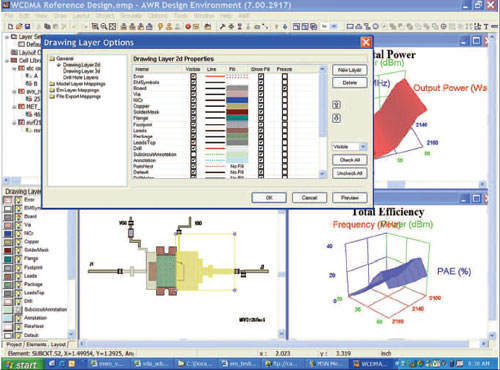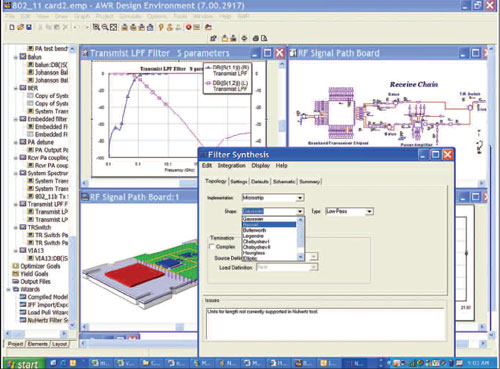
Electronic design automation (EDA) tools have traditionally been developed as separate sets of tools offering little or no interoperability with third-party tools. As the design of next-generation communications products evolves and becomes increasingly complex, the need for a more integrated tool flow is elevated, and it has become obvious to electronic designers that the closed, single solution is no longer a viable alternative. Tool interoperability has become so important that a panel including most of the biggest EDA vendors in the industry was convened at the 2005 IEEE International Microwave Symposium to discuss the issue. One panel member described the present EDA landscape as a feudal system in which each fiefdom has its own RF and microwave simulation software and does not want to integrate with third-party tools that compete with its own products. Perhaps the most significant presentation was made by industry guru Jim Rautio, president and CEO of Sonnet Software, who predicted that by the end of the decade, the relative success and failure of EDA vendors will be determined primarily by the relative success and failure of their interoperability efforts.
Answering the Interoperability Challenge
Applied Wave Research Inc. (AWR™) was founded on the philosophy of an open design platform, and its flagship product, Microwave Office® design suite, has completely revolutionized the communications design world by providing users with a choice. Built on the unique AWR high frequency design platform with its open design environment and advanced unified data model, Microwave Office design suite offers unprecedented openness and interoperability, enabling ease-of-use and the ability to integrate best-in-class tools for each part of the design process. The single, object-oriented database is inherently synchronized with schematic, simulation and layout data, providing everything a designer needs to take an idea from concept through simulation, and directly into physical implementation, all in one platform. Microwave Office design suite is much more than a design tool — it is a complete design flow offering all of the essential technology: linear and nonlinear circuit simulators, EM analysis tools, layout-versus-schematic checks, statistical design capabilities and parametric cell libraries with built-in design rule check (DRC). The Microwave Office 2006 solution delivers complete design closure between microwave IC, MMIC, package, module and PCB designs.
The Microwave Office 2006 design suite has been radically enhanced to provide the most powerful and flexible RF/microwave design environment available in the industry. This latest product release continues to deliver key productivity improvements to microwave designers, shortening design cycle time and speeding time-to-market for RF/microwave products.
Microwave Office Now Integrated with APLAC
With the acquisition of APLAC, AWR now offers a combination of APLAC’s incomparable RF simulation technology and AWR’s own robust simulators within the unique open AWR design platform. This provides designers with the best of both worlds: powerful, speedy simulation capabilities for both large and highly nonlinear designs within an easy-to-use, integrated design platform. APLAC’s RF design technology has been widely used by Nokia for years, and has been used in designing over 30 percent of all mobile phone RF integrated circuits (IC) worldwide. APLAC’s high performance, foundry-approved circuit simulation strength combined with the open, integrated AWR design environment within Microwave Office design suite offers high frequency designers a most powerful and proven simulation solution.
New EMediacy Unified and Integrated EM and Layout Editor
For the first time, the separate EM and layout editors that accomplish the creation of artwork are combined into one (see Figure 1), reducing design time by removing one editor that engineers need to learn, as well as the associated tasks required when combining the two original editors. In combination with the schematic EXTRACT feature, EM simulation is now immediately available within the circuit design flow, rather than being a disconnected and disjointed task in a top-down design process. The EMediacy™ editor changes the fundamental way designers access EM simulation, extraction and physical analysis by embedding them as logical extensions of circuit design without sacrificing their role in verification.

Fig. 1 The new EMediacy editor provides combined EM and layout editors.
Integrated Filter Synthesis Solution
AWR has answered the needs of customers for integrated filter synthesis by integrating into the Microwave Office 2006 design suite the industry-leading Nuhertz Technologies’ filter synthesis technology (see Figure 2). High frequency circuit designers can now perform accurate filter synthesis quickly and easily from within the unified AWR design platform. The feature offers complete synthesis capability for passive, transmission line, active, switched capacitor and digital filters, as well as two graphical user interfaces (GUI), one for the power user who requires advanced options and capabilities, and one for the mainstream user who needs ease-of-use. The intuitive, easy-to-use, wizard-like GUI walks the occasional filter designer quickly through the required data steps for the specification and synthesis of all the popular filter topologies and implementations, including diplexers. For power users, one mouse-click leads to the comprehensive Nuhertz GUI, which enables the designer to quickly generate data for detailed analysis, design centering and manufacturing trade-offs. Synthesized schematics and related analyses can then be stored and viewed directly in the AWR design platform.

Fig. 2 Nuhertz Technologies’ filter synthesis integrated into Microwave Office.
New EM Socket II Support Visualizations for Integrated Third-party Tools
As part of its ongoing commitment to providing customers with greater flexibility and choice in their design methodology, AWR has created the EM Socket™ open standard interface, which enables users to access a broad variety of EM tools from leading vendors, without leaving the Microwave Office design environment. All EM manipulation and visualization features that were a valuable part of AWR’s EMSight™ technology are now part of the EM Socket II interface to third-party tools. This enables EM Socket integrators like Sonnet, Zeland, Optimal, etc., to access current animations and E-field display.
Open Access to Proprietary AWR Xmodels
AWR now provides open access of its proprietary Xmodels technology to third-party EM analysis software vendors who wish to integrate with Microwave Office. AWR’s Xmodels are a group of discontinuity models that use the results of full-wave EM solutions of the parameterized discontinuity in order to estimate the electrical performance of the discontinuity. These models are a result of ongoing internal research and development at AWR in order to provide designers with the most accurate discontinuity models at a computational speed adequate for tuning, optimization and yield analysis. The AWR Xmodels have proven to be an efficient and reliable complement to full-wave EM simulation that not only enable the performance of various other important circuit analyses within Microwave Office, but also offer significant improvements in the accuracy of circuit simulations.
New Switch Views Feature
A new view-switching feature enables multiple schematic/electrical views for the same layout, simplifying linear/nonlinear/system simulation and layout-vs.-schematic check (LVS). It is often important to model or simulate a component in multiple ways, depending upon the focus of the problem at hand. Switch Views helps users to accomplish this task by enabling them to associate more than one schematic with the same piece of the layout. This is especially useful, for example, when an S-parameter file for an inductor is the model and an LVS representation is needed. Microwave Office 2006 now permits two simultaneous views: an S-parameter view for simulation and an inductor symbol for LVS for the schematic associated with same layout.
New Simulation Filters and Folder Management Feature
New simulation filters have been added that limit the scope of the project on which the simulators should focus, without disabling individual graphs or schematics. Currently, focusing on a particular simulation subset of a design requires disabling a number of graphs, schematics and EM structures. With the new Microwave Office simulation filters, engineers will be able to specify which parts of the design should be simulated. This streamlines the simulation process by focusing the sub-tasks, which may only need one or two of the analyses contained in a much larger, complex project.
Often the analyses of a circuit design are spread over a large number of graphs and schematics that are hard to keep track of. Project folders can now be created to group and manipulate related schematics and graphs in the design for quick reference. The Microwave Office 2006 design suite also provides new time-domain waveform measurements for use with harmonic balance and time-domain simulators. Eye diagrams and time-domain waveforms in general diagrams can now be broken down into certain well-known parameters. These parameters can be explicitly measured and used for optimization, design centering and yield analysis. Other enhancements to the software include: electrical rule check (ERC)/DRC enhancements and new advanced frequency sweep (AFS) capability for faster EMSight results
(3 to 5 time speed improvement) over a large bandwidth. AFS provides fast frequency sweep capability that enables EMSight to calculate a much more detailed response for broadband simulations by using a finite and smaller number of frequency points. Faster HSPICE simulation with support for larger arbitrary n-port devices is now offered as well (see Figure 3). Previously, designers were limited to the size of S-parameter files exported to HSPICE. The limit is now much higher, and the speed of the HSPICE core engine has been enhanced to the point where some tuning can actually be done in real time. Reporting of simulation warnings and errors has also been improved. Information, warnings and errors are now available in a tabbed dialog box for faster and easier disposition and resolution. The errors are also reported during simulation rather than after, enabling poorly formulated test cases to be canceled earlier in the simulation process rather than discovering errors at the end.

Fig. 3 Faster HSPICE simulation is offered in the Microwave Office 2006 suite.
A new license file-sensitive installer that simplifies administration of features has been included in the Microwave Office 2006 design suite. The installer for AWR products now reads the license file and assists the installer in identifying what configurations of AWR products should be accessible through the Start menu or desktop icons.
The future of EDA
AWR was founded on the concept of providing a superior solution through best-in-class technologies, tool interoperability and open third-party tool interfaces. The company continues to develop its own robust design flow in the Microwave Office 2006 design suite, which includes industry-leading technology such as the APLAC simulation engine. At the same time, its open architecture enables third-party tools to be easily integrated into the design flow, thus enabling new solutions to be created to address emerging design challenges and new applications. The Microwave Office 2006 design suite includes the most innovative integration technologies in the industry, such as the EM Open Socket™ interface. The software embodies AWR’s commitment to the open design platform philosophy and its leadership position in providing designers with the flexibility to integrate tools of choice at different stages of the design process for a superior design methodology.
Pricing and Availability
AWR will release the Microwave Office 2006 design suite to customers in Q1 2006. A beta version is available immediately for customers with support contracts. The product supports Windows 2000, XP and Linux. US list prices for yearly, time-based licenses range from $5000 to $40,000 depending upon configurations. For more information, contact AWR at info@appwave.com.
Applied Wave Research Inc.,
El Segundo, CA (310) 726-3000,
www.appwave.com.
RS No. 301
